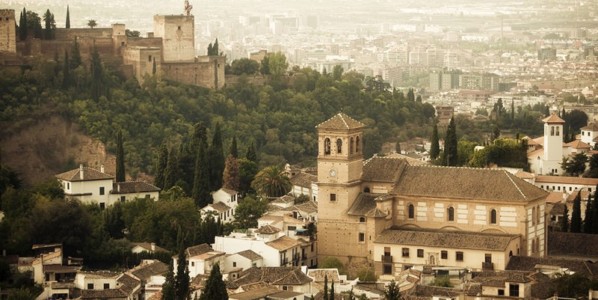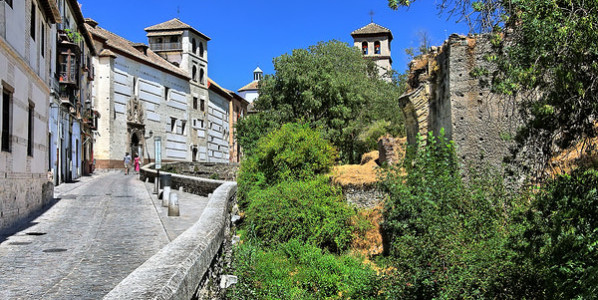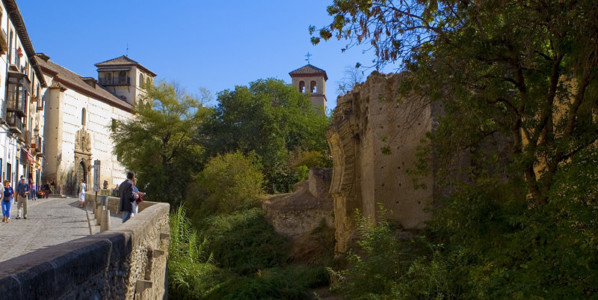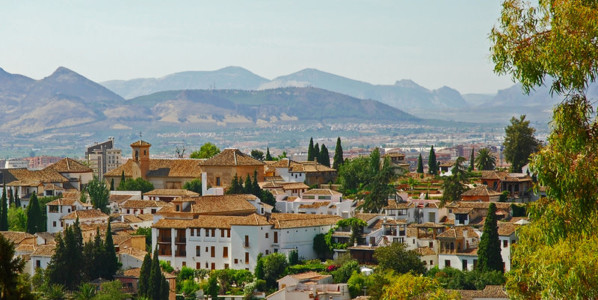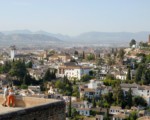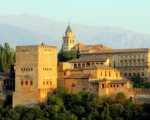Frente a la Alhambra
“The ‘Sabika’ Hill is a crown on Granada’s forehead, which they wanted to encrust with stars. And the Alhambra (may god protect her!) is a ruby at the top of the crown.” (Ibn Zamrak).
“Dazzled by the colour and sparkle of the sky, I was in state of ecstasy. I lost all notion of the present, and felt closeness of the Morisco past. delight mixed with sadness, asleep in the gardens, next to the flowing stream, dreaming of a far-off, unattainable paradise…” (Nicolás María López).
Granada’s Alhambra is a unique, exquisite link in humanity’s rich cultural heritage: it is the architectural jewel of al Andalus’ Hispano-Muslim art. Known the world over, it is Spain’s most visited monument. In order to protect and conserve it, in 1870 the historic-artistic site made up by the Alhambra, the Albayzín and the Generalife was designated a “National Property”, and in 1984, a “World Heritage Site” by UNESCO. “The Alhambra survives because it has been defended by the strongest force present in the human species. Love has conserved it.” (Emilio García Gómez).
The Alhambra’s origin goes back to the early years of Granada’s Nasrid dynasty and its first Sultan, Muhammad I al-Ahmar. Al-Ahmar entered Granada as its new sovereign, in 1238 and set up his court in the Alcazaba Cadima fortress. In the following year, however, he decided to move it to the al-Sabika hill (one of Sierra Nevada’s last foothills on the Granada plain), situated on the left hand bank of the Darro River, east of the city and opposite the Albayzín:
He inspected the area, chose the site and marked out the foundations of the castle; before the year was out high defensive constructions were already in place, which he supplied with water from the Darro River, building an irrigation channel and a dam.”
In Manuel Lafuente Alcántara’s History of Granada (1843-6), he says the following about the construction of the Alhambra:
“The king’s preferred project was the construction of the Alhambra Palace. Although he had rebuilt the Bermeja Towers, he wanted to construct a monument that would leave a lasting example of his taste and splendour to posterity. Under his personal direction, the Vela Tower was built, along with the solid blocks that make up the ‘Alcazaba’ (fortress) and he extended it to the Comares Tower. He directed the works, finances and registration himself, mixing modestly with the foremen and workmen to give instructions.”
Stone was brought from Escúzar, the Sierra Elvira Mountains, Loja and Santa Pudia, and marble from Macael to build it. Al-Ahmar never got to see his long-desired project of the red fortress completed. After a long and fruitful reign that had lasted 35 years, he died in 1273.
His descendents were to continue work on the monument (which was an attempt to reflect, on earth, the heavenly paradise of Allah). Yusuf I (1333-54) and Muhammad V (1354-5) carried out the most important and emblematic works. Ibn al-Jatib lived in the Alhambra and says the following:
“The Alhambra citadel, home to the Royal Court, dominates the town towards the south, rising above it with its white battlements, lofty towers, impregnable fortifications and high palaces, that dazzle the eyes and stagger the intelligence. Her abundant water overflows the ponds and cisterns and runs down forming streams, whose whisper can be heard from far away. Vast gardens and thick forest belonging to the Sultan surround the wall of the citadel making a green barrier behind which the white battlements can be seen shining like stars in the midst of a dark sky. There is not one single part of the citadel without vegetable gardens, ‘cármens’ or gardens.”
Tall reddish towers were built atop the hill like a magical apparition. They protected, within, a wealth of elegant, delicate architecture designed with water, plaster, air, colour and light, and so the Nasrid Alhambra took shape. The Alhambra’s Royal Fortress, standing like a great ship on the ridge of al-Sabika Hill, was made up of various different areas: the Alcazaba (military citadel to the west, on the highest point of the hill – a privileged spot from which to monitor and control the city below and the rest of the fortress complex), the Royal Palaces (Mexuar, Comares and Leones situated at the centre of the hill and separated from the Alcazaba by Aljibes square) and the town or Medina (to the east, where the houses of civil servants and craftsmen were located). The whole site was surrounded by walls with a combined length of 1,700 metres, including some thirty defensive towers.
Nasrid master craftsmen (labourers, carpenters, ceramicists, painters, plasterers, gardeners.) created an artistic miracle, and “one of the few places in the world where one can dream without trying.” (Gregorio Marañón Posadillo): plinths tiled in coloured, glazed ceramics, the finest three-dimensional mocarab plasterwork, vaults with looped supports, guilted interior domes, fountains worked in marble blocks, fretted latticework and epigraphy (in cufic or italic script) with the motto of the Catholic Monarchs, “Allah alone is victor”, passages from the Koran and verses of the poets Ibn al-Yayyab, Ibn al-Jatib, Ibn Zamrak and Ibn Furkún. Their distribution, interior spaces and decoration have perfect harmony of proportion, based on the rigid geometry of the circle, the square and the equilateral triangle. After 254 years, in a death that had been on the horizon for years, Granada’s last Nasrid king, Boabdil, handed over the keys of the royal city to the Catholic Monarchs, bringing the Nasrid kingdom of Granada and Hispano-Muslim al-Andalus’s last glory to an end.
Emperor Charles V repaired the defensive walls and buildings and ordered the construction of a palace bearing his name, next to the Nasrid palaces. This was to be a magnificent monument of the Spanish Renaissance, and the work was commissioned to the architect Pedro Machuca (work began in 1527 and went on in interminable fits and starts until its final completion in 1957). We bid farewell to the Alhambra with the words the American writer and diplomat Washington Irving used after his journey to Granada in 1829:
“The setting sun spilled a melancholy sparkle over the ruddy towers of the Alhambra. I could hardly make out the window of the Comares Tower, where I had given myself up to so many delicious fantasies. The host of copses and gardens that surround the city were golden in the light of the sun, and the violet mist of the AUTUMN night hovered over the plain; all was beautiful, but also tender and sad as I looked out for the last time. I have to get away from this place, I thought, before the sun sets. I will take away with me a memory wrapped up in its wealth of beauty.
Text and compilation of quotations: ANTONIO GÁMEZ

